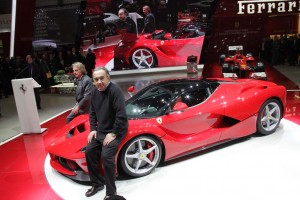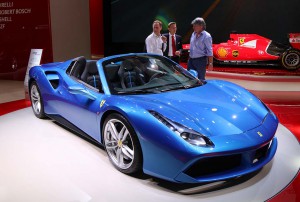The new Ferrari 488 Spider will launch you from 0 to 60 in barely three seconds. Now, parent Fiat Chrysler is hoping Ferrari itself will burn rubber when it launches trading on the New York Stock Exchange Wednesday.
The trans-Atlantic automaker recently announced plans to sell off a 10% stake in Ferrari at somewhere between $48 and $52 a share, the actually price set to be announced today. That’s a fair bit higher than many analysts had expected when plans for an IPO were first announced last year – and that reflects FCA’s optimism that the Ferrari brand will become one of the rare gotta-have automotive stocks.
There are plenty of reasons to be optimistic. As many Wall Street traders might tell you, there’s a long waiting line for Ferrari sports cars, something the Italian maker hopes to tap with a modest rise in production. And it is betting it can tap into booming global demand for luxury goods through new licensing agreements that could land the brand’s prancing pony logo on a variety of upscale products.
That said, industry observers question just how far Ferrari can push things without damaging its exclusive image. “It’s potentially risky,” cautions automotive analyst Stephanie Brinley, of IHS Automotive. “You don’t know if you’ve made one too many until you trip over it.”
(Click Here to check out the new Ferrari 488 Spider.)

FCA CEO Sergio Marchionne and former Ferrari CEO Luca di Montezemolo before their split over Ferrari production caps.
The good news for Ferrari is that other high-line brands have shown there’s a surprising amount of elasticity in the global market. At the beginning of the millennium, sales of vehicles prices at $150,000 and above – about $207,000 in today’s inflation-adjusted dollars – totaled barely 10,000 annually. That’s more than doubled over the last 15 years. Bentley alone sold 11,020 vehicles last year and expects a big spike in 2016 when it launches the Bentayga, its first-ever SUV.
Not everyone is convinced Ferrari should follow Bentley’s lead. That includes Luca di Montezemolo, the long-time CEO who was fired last year, insiders suggest, primarily over a dispute over expanding production. Montezemolo wanted to hold at around 7,000 sports car annually. FCA CEO Sergio Marchionne thought there was plenty of upside.
In the Ferrari IPO prospectus, the carmaker said it would reach 9,000 vehicles annually by 2019, something Adam Wyden, managing member of ADW Capital Management LLC called “conservative.” During this month’s road show to pitch the IPO, Marchionne seemed to suggest Ferrari could reach even higher, noting that production this year will already reach 7,700.
“There’s a tremendous opportunity to grow in emerging markets like India and China,” said Joe Phillippi, a long-time Wall Street analyst now working as an industry consultant with AutoTrends Consulting. Predicting Ferrari might come out of the IPO with a target of 15% annually growth, Phillippi believes the brand actually might “nudge” 10,000 by 2019, if not earlier.
Appealing to emerging markets appears to be the key to a post-IPO Ferrari’s success. China, in particular, is already the world’s second-largest luxury vehicle market, and a number of high-line brands, such as Audi, already sell more vehicles there than in the U.S. The question is whether the sudden slowdown in the overall Chinese market will hurt Ferrari’s growth plans.
(For more on Ferrari’s growth plans, Click Here.)
Another question is where Ferrari will go to grow, said Phillippi. Bentley and Rolls-Royce found opportunity to push down-market, at least a bit, in their search for volume. Now, Bentley is adding an SUV, reflecting broader market trends. And while it will be the first premium-luxury automaker to enter the utility market, it won’t be alone for long. Among the brands set to follow are Aston-Martin, Lamborghini, Maserati and Rolls.
Ferrari, however, won’t even consider a four-door model – or at least it wouldn’t under former CEO Montezemolo. Its wagon-like FF model does have four seats and a big cargo compartment, but still only two doors.
Where Ferrari seems most open to exploring new territory is in the luxury goods market. It has done a handful of cross-marketing ventures over the years, even lending its logo to a high-end laptop computer. But expect such arrangements to rapidly multiply going forward. And that worries analyst Brinley even more than a boost in sports car production.
“They could change the perception of the brand if they pick the wrong items,” she says, adding that, “much more than whether it’s sunglasses or luggage, it has to do with the quality of the items (they lend their name to). If the quality isn’t there it will devalue the brand.”
The Ferrari road show proved to be almost as popular as the maker’s cars, attendance reportedly running well beyond initial estimates. But whether that signals a strong demand for the stock won’t become apparent until later this week.
(The end may be near for the Dodge Viper. Click Here to see why.)

